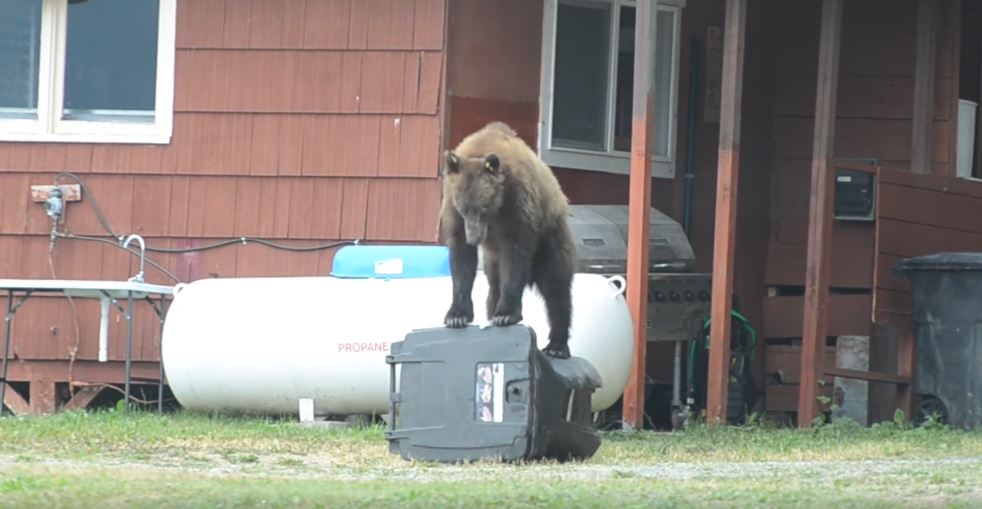Alaska Fish & Wildlife News
February 2023
The bear with a jug stuck on its head
and other tales of animal interventions
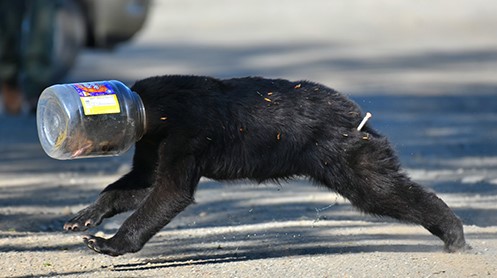
Wildlife biologists in Alaska have untangled moose from telephone wires, fences, and swing sets; they’ve helped bear cubs out of dumpsters, extracted muskrats and marmots, pulled quills out of moose and pulled moose out of homes. And yes, they’ve pulled jars off bears’ heads.
Contrary to popular belief, rescuing animals is not a big part of the job of a wildlife biologist. But sometimes these scenarios work out for people and the animals.
“People always hear about the negative stuff, a bear mauled somebody or we had to kill a bear, but often we do get involved in things with a positive outcome,” said Dave Battle, a state wildlife biologist in Anchorage.
The municipality is home to brown and black bears, some wolf packs, a few hundred moose and an assortment of lynx, muskrat, coyotes, foxes and porcupines. That’s not a comprehensive list, but given the roughly 300,000 people in Anchorage, it provides ample opportunity for human-wildlife interactions.
The young black bear with a cheese ball bucket on his head is one example. On a warm late-spring evening in 2022, Battle and his colleague Cory Stantorf worked with the bear in a wooded area on Joint Base Elmendorf-Richardson (JBER), the large Air Force/Army base on the north side of town. Conservation Officers with the Joint Base had located the bear and were standing by to help.
“It’s always a little hinky with a black bear and trees – if he gets a jab in the butt from a dart, the first thing he’ll do is climb up a tree,” Battle said. No one wants a drugged bear to fall out of a tree, and this bear climbed a tree before he was darted, as soon as he saw Battle through the bottom of the bucket.
“He went up about 20 feet, so we quieted down and he finally came down. I wanted to get him away from the trees, so I walked up to him slowly and quietly and used gradual pressure to herd him physically away, a step at a time. He couldn’t hear well with that bucket on his head, he couldn’t place sound – I’d make a noise and he’d look in the opposite direction, and he couldn’t smell. He’s looking through the bottom of it and he could tell I was there but didn’t seem to be able to tell exactly where or what I was. I got him about 20 feet away from the trees and got a dart in him.”
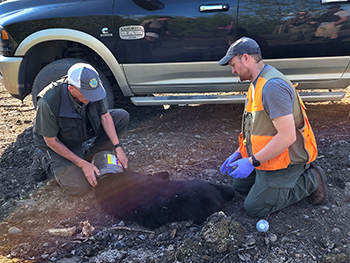
The bear ran into a thicket of saplings and the crew watched him settle down in the brush. They didn’t realize it, but he was in a small, water-filled depression.
“He was in the water but the bucket floated his head, protected him, and his face wasn’t even wet,” Battle said. “We got the bucket off pretty easily; I’m surprised he didn’t get it off himself. I’m sure there had been some good smells in there.”
The bear had no history of being a nuisance, so they gave him an ear tag and released him.
“This happens more frequently than people know,” said Stephanie Sell, a wildlife biologist in Juneau. She and her colleague Chad Rice helped a bear with a giant animal cracker jug stuck on his face. “It was clear so it could kind of see, but every time it would breathe the jug would fog up.”
“There’s no manual on how to take care of these situations,” she said. “You hope whatever information you got over the phone is accurate, but en route, you don’t know what you’re getting into. Then you get on the scene and have to quickly assess the situation.”
“We started looking at 7 am, and we couldn’t find it,” she said. “Chad and I had a flight to Gustavus that afternoon to manage a moose hunt, so by afternoon we had packed up everything. We were on the way to the airport when we got a call from the police, ‘This bear is by the cemetery and people are trying to take this jug off this bear’s head.’ I changed our flight, and we backtracked to collect everything we had just locked up and went to find the bear.”
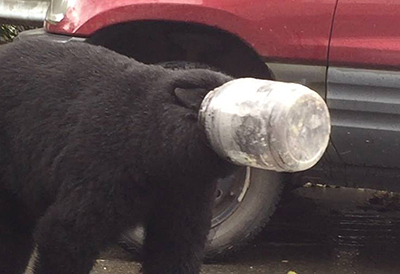
The police were on the scene, trying to manage the crowd and to keep track of the 200-pound adult bear, all moving targets in an eight-block radius.
“It was absolute chaos,” Sell said. “I’m loading a dart and this woman is yelling at me for taking so long. We corner the bear, dart it, and pulled the jug off its head. It was on there pretty good; it was caught on his cheek bones but not over his ears. Chad was pulling on me, I’m pulling on the jug with my feet on the bear’s shoulders. It actually popped when it came off. And the whole time we’re being yelled at by this woman.”
The bear did not have a history, so they ran out the road and released it, rushed back to lock up the drugs and dart gun, then drove to the airport (while taking calls from the media) in time to catch the last flight to Gustavus.
“I remember a bear had its head caught in a sink once,” said Dave Battle. “Moose get caught a lot more. Moose don’t have paws to get stuff off, but bears can free themselves more easily.”
Tangled up
Battle said fall is “moose entanglement season,” and some years he sees a dozen cases. It’s mating season and bulls are rubbing their antlers to get the velvet off, they’re raking and scraping on everything they come to - what hunters call “horning bushes,” showing off for females and attempting to intimidate rivals.
“We have half the people in the state in Anchorage, and that’s a lot of Christmas lights, volleyball nets, rope swings and stuff to get entangled in,” he said. “Sometimes it’s a few strands of rope dangling down. If it looks like it’s about to come off, or it’s late in the year and it’s going to shed soon anyway, we’ll leave it. If it’s interfering with walking or feeding, we dart it and get it off. If it’s anchored to something we’re definitely going to dart it and get it free. It’s always a judgement call.”
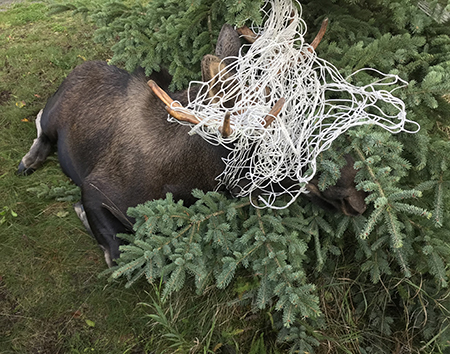
A few years ago wildlife biologists Roy Churchwell and Kevin White, based in Juneau, were called out to Gustavus, about 50 miles west near Glacier Bay National Park. A bull moose was caught in a fence. Someone in the small community had strung a seine net on a cable to serve as a garden fence.
“The moose got caught in the netting when it was trying to get to the garden,” Churchwell said. “We thought it’d be easy to go over there, dart it in the butt and then get it loose, but in the night it broke loose and got out into the willows.”
The moose was dragging a mess of netting, and had a big wad tangled up in his antlers. They tracked it to a patch of willows and White slipped in and darted it. Once immobilized, they cut it free.
“We don’t manage individual animals,” he said, “but sometimes if there’s an opportunity to help in a particular case, we can, especially if it’s a human cause. That gives me more incentive to go in and try and help out. Not that I wouldn’t help an injured animal if I could, but often an injured animal needs the help of a vet, and that’s not an option for us. People think we are vets, or have quick access to vets. But local vets are busy taking care of peoples’ dogs and cats.”
“We don’t have the staff or a facility to do rehabilitation and release animals,” said Stephanie Sell, who preceded Churchwell managing the Juneau area and northern Southeast Alaska. “The public doesn’t realize how few people manage such a large area – two or three people working 24/7 for all of northern Southeast Alaska. In any given day there are multiple things happening with wildlife. And we tended to focus on Juneau, where there are more people – especially in the summer with tourists – and subsequently more wildlife conflicts.”
Many of those conflicts involve bears, and it's a common misconception that bears can simply be captured and relocated. Ideally, biologists need to put a lot of space between people and bears. With Juneau’s limited road system (Juneau is not connected by road to any other road system) that means putting them on a boat, which isn’t always practical with weather, timing, and personnel.
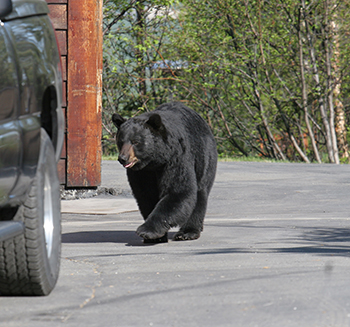
“Bears just come back if they’re relocated on the road system,” she said. “We’ve had some success stories, but we’ve seen with collar data, they return within days, or weeks, and get into the same problems.”
Food conditioned bears return to neighborhoods where they remember finding easy meals and are then sometimes killed by homeowners, police, or Fish and Game when they become persistent. Or they find new neighborhoods and return to their old, learned behaviors, because they associate people with food, increasing their likelihood of being killed. This is known as DLP – killing in Defense of Life and Property.
In Alaska, pretty much anywhere that’s suitable bear habitat already has bears in it. Introducing bears into unfamiliar natural settings puts undue stress on the animal. Similarly, relocation can be unwise for other reasons.
“If we’re dealing with a bear that’s tearing into a home, we can’t justify putting a destructive bear back into the environment,” Sell said. “Some people latch on to the idea of placement, but it’s a high-risk situation and very stressful on bears to try and place them after they are about four or five months old. Bears can live 20 to 30 years in captivity and the reality is that many zoos are at capacity. Alaska isn’t the only state that has black bears needing placement. We are constantly required to make hard, split-second decisions.”
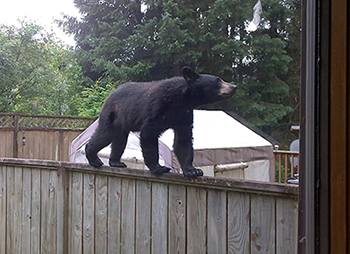
Like many wildlife biologists in Alaska, Sell has had to euthanize bears as part of her job. One event stands out. A motorcyclist “out the road” north of Juneau crashed into a bear early in the morning, killing it, and seriously injuring him. Sell and Chad Rice were called out to pick up the dead bear, and she discovered it was a lactating female. A search of the area revealed two small cubs in a tree. They didn’t stand a chance of surviving at that age without their mother, and there was no placement available. Sell said being told that the only option was to euthanize the cubs was horrible.
“It’s horrible every time,” she said. “It’s probably the worst part of my job. There’s a lot of silence in the truck after you do something like that. Newspaper articles swept the state and Lower 48 with the headline, ‘Black bear dies in collision with motorcycle, cubs euthanized.’ People sent me hate mail and acted like it didn’t affect me - complete strangers saying I’m ‘heartless’ or ‘cruel’ and ‘how could you’? We do our jobs and somehow we have to compartmentalize all the bad stuff and move forward- but that part isn’t easy. It takes a mental and emotional toll.”
Bears inside
Bears are agile, curious and strong - like 200-pound racoons, one biologist said. They explore new places that might provide food – behavior that draws them into garages, houses, and grocery stores with automatic door openers. But they don’t always exit the same way.
“Many times, bears caught in a structure just need a way out,” Sell said. “Generally we can open a door for them and they take off - hopefully it’s a door that swings out so you have a barrier between you and the bear! If it swings in, that gets a little more exciting as we try to use something long like a broom or shovel to help push the door open and hopefully you have time to get back out of the way.”

Bears in Anchorage and Juneau have learned how to open car doors – from the outside, but not the inside. Juneau biologist Ryan Scott has dealt with close to a dozen bears that have gotten trapped in cars. Consistent with Sell’s description above, the biologist typically jumps out of a truck, opens a car door and jumps back in the truck as the bear bolts from the vehicle.
The Toyota Prius seems to be a popular model, perhaps the door handle is well suited to bear paws, or the doors swing shut more easily. An attractant is often involved. A lucky Subaru owner noted one morning that a bear slurped up a leftover latte in her cupholder and exited the car leaving only pawprints.
Sometimes the trapped bear is honking the horn as it bumps around trying to get out, and also tearing up the seats and shredding the ceiling fabric.
“One bear completely tore the dashboard out,” Scott said. “I got a call and before I was even out the door they called back and said it went out through the window.”
They trash the cars, sometimes so extensively they must be towed away. “I’ve written letters to insurance companies,” Scott said. “Confirming that a bear really did what people claimed.”
One fall day, he got a call about two cubs in the dumpster of a downtown pizza parlor. A mother with two cubs of the year had been in the area, but she was nowhere to be found. Scott and colleagues Neil Barten and Christine Schmale checked the dumpster, and there at the bottom were two cubs, one was asleep. They were too small to climb out, so they pulled them out. They returned that night with the cubs and set a culvert trap. Sure enough, an adult showed up and walked right in. They darted the bear, which upon inspection was indeed a lactating female.
“She came around and they were talking back and forth, so we put her out again and loaded them all together,” he said. “They were fine. We released them and never had any trouble from them again.”
Darts and drugs
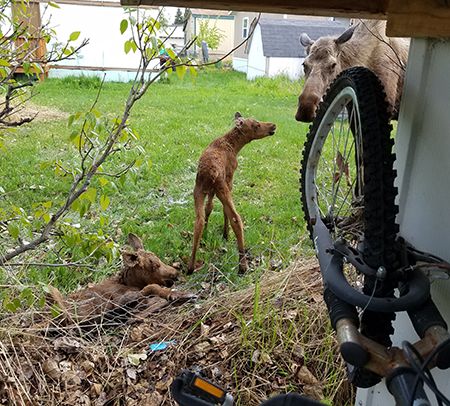
Dave Battle had a similar experience in Anchorage. Fortunately, no drugs were required.
“We pulled up in the truck and there were these three cubs squalling in a dumpster,” he said. “They got in a metal dumpster and mom could get out but they couldn’t. She was hanging out right there on the other side and she wasn’t showing any signs of aggression. We looked around and saw a ladder leaning against a nearby fence, so we put it with them down in there and they climbed right out.”
Drugs are carefully regulated, and biologists don’t carry them unless they know they need them. So when they arrive on the scene, it’s not always a simple matter of darting the animal.
“One time this moose calf got its foot stuck in a chain link fence that was laying on the ground, next to a shed,” he said. “Mom was right there and its sibling, these are young calves in May. I’d try to help, pulling it free, and mom would charge over and I’d jump in the shed and close the door. I finally got its leg unstuck and they moved on.”
“I could’ve darted her, but there was the shed right next to it. I didn’t have the drugs and would had to go back to the office and get them out of the safe, and the longer it stays stuck the more chance there is of it getting injured. We had time to help that moose out, but that’s not always true with all the other calls we’ve got.”
“We’re not a wildlife rescue organization,” he said. “We manage populations, but were not heartless. If we have time to, we’re happy to help when we can.”
Battle said his job is the big picture. “How is the entire population doing, is the entire population healthy,” he said. “Managing a hunt – that involves hundreds of animals. We keep stats on how many animals are harvested, how many are killed on roads. We do surveys, and if we see from the surveys that we have plenty of moose, we might give out more tags.”
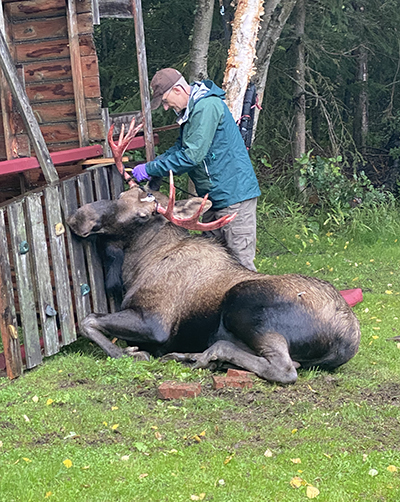
People, on the other hand, focus on individual animals – and that’s understandable.
“We get a lot of calls that an animal is in distress in someone’s yard, or a calf is in someone’s yard and they’re afraid a bear will get it. But it’s very common behavior for a cow to leave a calf alone while she goes to feed. A bear might get it – but that’s a natural event. It’s happening all over Alaska. The difference is a person is watching this one, and so now it’s a personal thing.”
A common response is someone offers to call a captive facility like the Alaska Zoo or the Alaska Wildlife Conservation Center (AWCC) and see if they can take the animal. “I’ll say, we have a biologist who does that nationwide,” Battle said. “The people who answer the phone at these facilities will sometimes say, ‘Sure, have Fish and Game call us!’”
This is awkward. The concerned citizen often does not have important details, like the age and size of the animal, or if it is sick or injured, and the person on the phone may not be the appropriate contact. But now the story is, “A zoo offered to take the bear cub and Fish and Game just euthanized it.”
Don’t fence me in
Battle said cow moose and calves in the spring often find themselves separated by a fence, typically a chain link fence.
“They’re walking along next to each other, but then the calf is on one side of the fence and mom is on the other, and then mom starts to walk away and they realize they’re separated,” Battle said. “She won’t step away and go around the fence – if she can see the calf she just stays right there. The calf can’t go very long without mom at that age, it needs milk.”
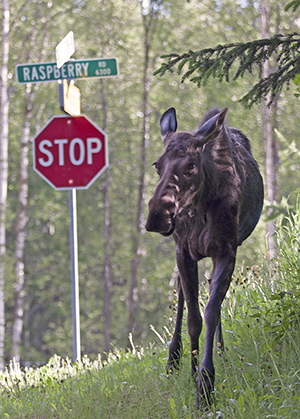
This creates a very dangerous situation and it’s a public safety issue to reunite them.
“Those cows have a short fuse when calves are young.” Battle said. “We have eight to 12 moose attacks a year in Anchorage, and many are in late-May to mid-June. That time of year everything with sharp teeth is hunting those little calves and the mother’s instinct is to grind anything she perceives as a threat into the dust. People have heard, ‘Don’t get between a cow and calf,” but she’s so much more dangerous that time of the year. Don’t even get close to them!”
Often, moose-herding works. It takes a lot of experience and judgment, Battle said, but sometimes you can put gradual pressure on the calf, and get it to run around the fence to its mother. Getting moose to backtrack is hard for them conceptually, so very often it’s a matter of running in and grabbing the calf and taking it around the fence to the cow to reunite them. However, while moose are not usually motivated to jump a six-foot fence, if you grab a young calf, that is often enough motivation for the cow to come across the fence. When that happens, the problem is solved since the cow and the calf are now on the same side of the fence. And as long as staff can get away from her fast enough, no harm done.
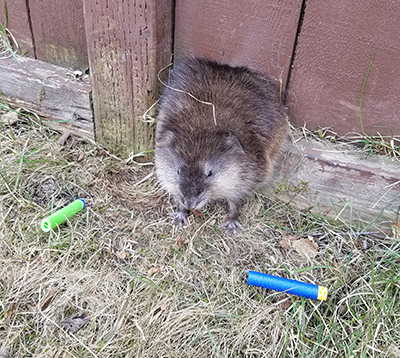 Battle’s smallest assist was a muskrat. The rodent squeezed into a too-small hole in a fence and got stuck. Wearing heavy gloves he tried to manipulate it in or out.
Battle’s smallest assist was a muskrat. The rodent squeezed into a too-small hole in a fence and got stuck. Wearing heavy gloves he tried to manipulate it in or out.
“It was not coming out either direction, no way, so I got permission from the homeowner to take the board off the fence and very delicately saw it until I could break the side of it out and let him out.”
Quills
“Every once in a while we’ll get a call about a moose with quills in her legs,” Battle said. “Last time it was a cow in the spring with fairly young calves. It looked like she stomped a porcupine – she had quills all up in her legs, and we were getting a lot of reports on it. She was staying with her calf right next to the Elmendorf hospital. We were able to dart it, get those quills out and give her some antibiotics.”
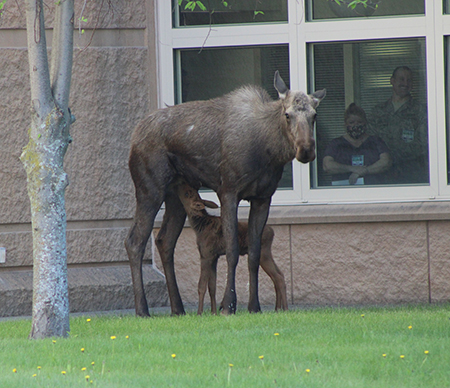
Ryan Scott, Chad Rice and Stephanie Sell responded to a similar call, in downtown Juneau, involving a Sitka black-tailed deer. The Alaska State Museum was being rebuilt and the deer was in the middle of the construction site, impeding the workers. Their first thought was to relocate her, but then they saw her face.
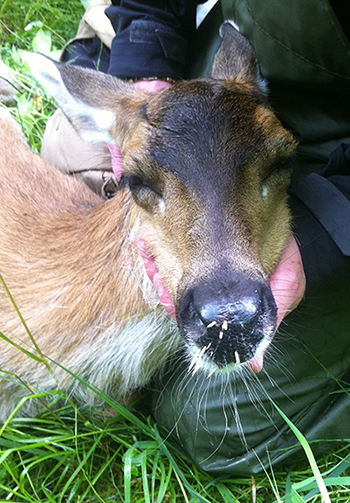
“She had all these porcupine quills in her snout, so we wanted to pull them out,” Sell said. “I hadn’t immobilized a deer before, so we called the Sitka biologist (Phil Mooney) for advice on drug dosages. We attached an ear tag to indicate she had been handled by ADF&G and let her go in a more natural environment. A couple reports from the public indicated she had been seen in Thane and even on Douglas so at some point she swam across the channel.” Unfortunately, a couple years later she was hit by a car on the road right by the Alaska State Museum.
“She was clearly an urban deer, and very comfortable being right around town,” Sell said.
Outside in
One of the most recent and most bizarre incidents occurred in November 2022. A 400-pound winter calf (almost a yearling) fell into a big window well in a suburban home and was stuck at the bottom. Battle got the call at 2:30 am from the Alaska Wildlife Trooper dispatch. He and Cory Stantorf were on the way when the calf broke through the window and was in the house. It was cut from the glass and bleeding.
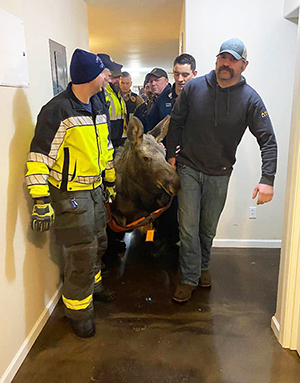
“It had fallen into a bedroom and then moved into a bigger area in the basement,” Battle said. A straight set of stairs, not too steep, led out of the basement, but the moose wouldn’t budge.
“You can’t get a moose to climb a set of stairs, it wouldn’t even consider it,” he said. “Cory had the idea if we darted it and called the Anchorage Fire Department, we could get it on a capture tarp and with six or eight guys carry it out.”
The tarp is heavy duty, with handles, and it was a good plan. They got it out in the yard but the moose was really fighting the drugs, and before they could treat the cuts it began struggling to get up.
“While I held it down, Cory put the ear tag in really quick and then we reversed the drug,” he said. “We could tell there was no glass stuck in the wounds but we couldn’t clean it up or anything. I got reports over the next week or two and it seemed to be doing okay.”
Battle said the incident was very unusual, and then out of the blue it happened again on the Kenai Peninsula. “It was so bizarre. Nick Fowler calls me a week later and said, ‘You’ll never guess where I’m going.’ He also got the firefighters to help out. We work with a lot of other agencies, and fire fighters are usually young strapping guys and gals that are physically capable, have a lot of tools and a can-do attitude and can figure out how to get things done.”
Like Fish and Game biologists, this kind of work is not their primary responsibility. But if they are able to help, they will.
This is the first of several articles on helping wildlife. Next month we'll look at marine mammals, and the realities of placing animals in zoos and wildlife facilities.
Riley Woodford is the editor of Alaska Fish and wildlife News and produces the Sounds Wild! radio program.
Subscribe to be notified about new issues
Receive a monthly notice about new issues and articles.

